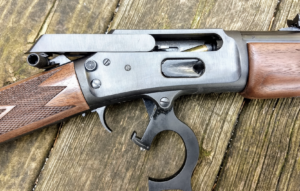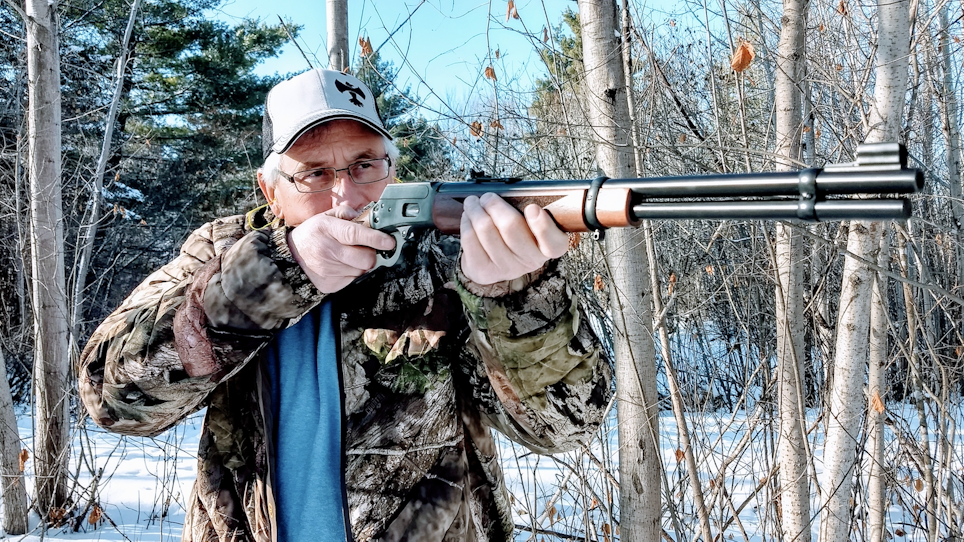Say what you want about the high-tech firearms on the market today — the tactical, the long-range tack drivers and the semi-auto wonders laying down veritable fields of fire — the lever action remains an American favorite.
The lever action’s connection to the Old West is undeniable and certainly part of its appeal. But another key reason the lever action remains popular more than 100 years after the original Winchester Model 1894 was introduced is the pure functionality of the rifle itself. Easy to load, accurate and extremely maneuverable, the lever action is also a lot of fun to shoot.
Marlin Firearms recently debuted a redesigned lever action that is sure to attract attention, the Model 1894C chambered in .357 Mag/.38 Spl. Marlin had an 1894C in this caliber combination previously, but reintroduced it late last year after a near-complete overhaul from an engineering standpoint. Marlin engineers kept the same basic design but tweaked several parts to make both calibers feed much more efficiently.
Marlin recently sent me a new Model 1894C to test and evaluate. I was a little suspicious about the notion of a handgun caliber in a long gun. My feeling has always been that handgun calibers belong in … handguns. My basic question: “What functions does this handgun chambering in a carbine accomplish that the handgun does not?”
After several range sessions with the Model 1894C, my questions were answered. The long-gun application of the handgun caliber makes the rounds more accurate and more powerful, and therefore more useable in the field. In this case, the Model 1894C will make a fine truck gun, is a great choice for a youth rifle, and has many applications for hunting, plinking and even home defense.
Testing the Model 1894C
My test Model 1894C arrived with iron sights, and a nicely checkered wood stock and forend. I headed to my outdoor range to see what the rifle could do, along with three different brands of .357 Mag ammunition: Aguila with a 158-grain semi-jacketed soft point bullets; Remington Performance Wheelgun and 158-grain semi-wadcutter projectiles; and, Winchester’s PDX1 Defender load topped with 125-grain bonded-jacketed hollow points.

Marlin Firearms has retooled the Model 1894C, which now is chambered in .357 Mag/.38 Spl. (Photo: Brian McCombie)
I decided my accuracy testing would be at the 50-yard mark, given the iron sights and my no-longer-young eyes. I had no problem pegging 1.5- to 2.0-inch five-shot groups with the Remington and Winchester rounds. My best grouping was with the Remington Performance Wheelgun at 1.18 inches — and four of those shots measured just .63 inches.
The Marlin and the Aguila, though, did not mesh. The very best I could do with this combination was a single 2-inch group. Most groups, though, were 3 inches or larger.
Next, I ran 50 rounds of various .38 Spl. rounds through the rifle — without a hitch. That’s important. Dual-caliber levers can struggle when going from one caliber to another, and some earlier versions of the 1894C suffered from this problem. But not the Marlin 1894C, and that makes the .38 Spl. a nearly recoil-less practice and plinking option. Per round, the .38 Spl. is also less expensive than .357 Mag., a small but nice selling point for the budget-conscious customer.
The lever and bolt on the 1894C worked smoothly and easily, even when the rifle was on my shoulder. In nearly 200 rounds, I didn’t have a single hang up or feeding issue. The rifle features a cross-bolt type safety, with a bright red “Fire” indicator on the left side of the receiver that’s easy to see.
Rounds loaded easily into the side port, and the spring in the tubal magazine provided consistent pressure and clean feeding, whether I had the tube fully loaded with nine rounds or had only a couple rounds inserted.
The checkering on the walnut stock and forend of the Marlin 1894C was nicely done, and deep enough for a very positive grip.
The trigger breaks at a nice, crisp 4 pounds, 5 ounces, according to my Lyman Digital Trigger Pull Gauge.
The one thing I would change on the rifle? The sights. Now, I fully admit to having 59-year-old eyes and that’s a real factor here. But I found the hooded front post difficult to pick up in lower-light conditions, and felt the rear blade should have a slightly wider notch. A white outline on that notch would be a big help, too. All of which may not be a factor for younger shooters.
The rifle’s receiver is drilled and tapped for a scope, and Marlin includes an easily-attached hammer spur to make life with a scope much easier.
Performance of the Model 1894C
I measured 10 rounds of each brand of .357 Mag ammunition using my PACT Professional-XP Chronograph from Brownells, and the 18.5-inch barrel on the 1894C actually did produce noticeably higher velocities, anywhere from an extra 200 to 250 fps.
For example, the Winchester PDX1 Defender round leaves the muzzle of a 6-inch handgun barrel at 1,325 fps and achieves 487 ft-lbs. of energy. At 25 yards, the muzzle energy is at 422 ft-lbs., and 371 ft-lbs. at 50 yards, according to two online ballistic calculators.
But, the same round through the Marlin 1894C has a muzzle velocity of 1,516 fps, with 638 ft-lbs. of energy. At 25 yards, the bullet is moving at 1,404 fps and delivers 547 ft-lbs. of energy. At 50 yards, the bullet still zips along at 1,304 fps (nearly the same velocity of a handgun at the muzzle) with 472 ft-lbs. of energy.
It’s not exactly a water buffalo killer, but plenty of people take deer and hogs every hunting season with .357 Mag revolvers. Using the Marlin 1894C lever action instead will boost the .357 Magnum’s energy and range noticeably.
Model 1894C Selling Points
When asked about a possible youth rifle or a truck gun, your sales staff would do well to offer the Marlin 1894C as an option. Have staff point out the shorter barrel, the maneuverability of the rifle and that even using the harder-hitting .357 Mag, the rifle has relatively little recoil. It’s also an effective hunting rifle.
“The 1894C in 357 is a great varmint round and even appropriate for deer at modest ranges,” says Eric Lundgren, marlin’s senior product manager. “And we are seeing a lot of folks use a lever rifle as a personal protection gun. The .38 Spl. makes the rifle into a great plinker and is popular because of the lack of recoil.”
Lundgren also suggested that the rifle’s ability to use and switch between the two calibers be stressed to potential buyers.
“Feeding problems can occur with rifles that take two cartridges, like the .357 Mag/.38 Spl. and .44 Mag/.44 S&S Spl.,” he noted. “And, some ammunition types work well when others don’t. At first, our engineers could get an extremely low malfunction rate on the .38 Spl. loads, for example, but not on the .357 Mag. It took a good while and a lot of tweaking to get them both to run very well, with a wide variety of ammunition types.”
When it comes to displaying the 1894C, get creative. In a gun rack lined up with other wood-stocked lever actions, for example, none of the levers are really going to stand out. So, to make the 1894C more noticeable you might consider a separate display and something calling attention to the fact it fires both .38 Spl. and .357 Mag rounds. Display the gun with boxes of both ammunition.
By themselves, those boxes will educate some customers to the dual-caliber nature of the rifle. Other customers might be a bit confused and ask what’s up with the different rounds — a conversation starter that can lead to a sale.
Also consider attaching the 1894C’s hammer spur. This will let potential buyers know the spur is included. The spur also gives the 1894C an almost tactical look that can’t help but appeal to younger shooters.
Marlin Firearms Dealer Support
For 2019 and beyond, FFL retailers carrying Marlin rifles can expect a good deal of marketing help from Marlin itself, for the 1894C and the Marlin line as a whole.
“Marketing for Marlin has been somewhat lack-luster over the past few years,” Lundgren admits. “But we’ve made some real changes to improve our marketing program. In 2017 and 2018, Marlin began moving past simply bringing old platforms back. We focused on adding new products with new features.
“Our retailers can expect much more of this in 2019. And our marketing department is committed to supporting the brand and its products in print, online and even on television. Consumers will start seeing the brand with increased frequency, this year and beyond.”
Featured image: Marlin has retooled the iconic 1894C lever-action rifle with new calibers to appeal to more consumers for sport shooting and hunting. (Photo: Kat Ainsworth)




